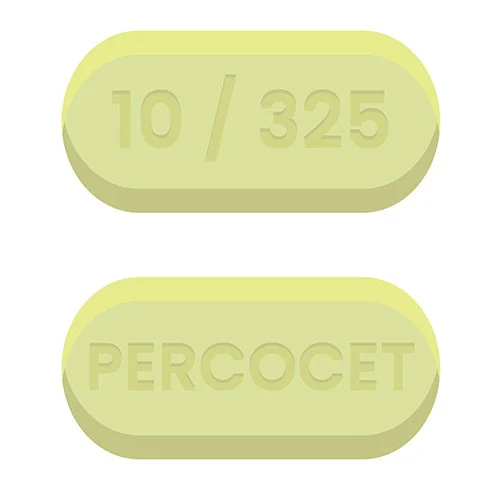People often wonder what Percocet looks like, whether or not there is yellow Percocet, and generally how to identify the drug.
Article at a Glance:
- Percocet is a prescription opioid painkiller that has the potential for abuse.
- Most Percocet comes in a yellow oval shape, but pills can also be white, blue and round.
- Percocet dosages printed on pills range from 2.5 mg to 10 mg.
- People may take higher dosages of Percocet than prescribed to feel the release of dopamine.
- The Recovery Village has treatment solutions available for people struggling with Percocet addiction.
What Does a Percocet Pill Look Like?
First, yellow Percocet is prevalent. Usually, the highest dosage is yellow Percocet and is often an elliptical or oval shape. If the Percocet is generic, it may also be yellow. Generally, yellow Percocet is the 10mg/325mg prescription, regardless of whether it’s generic or brand name.

Lower doses of Percocet tend to be white and round. It may be imprinted with “Percocet” if it’s the brand name, and it may also have a number on it that represents how much oxycodone it contains.Some brand-name Percocet pills may also be blue and round.
Yellow Percocet Counterfeit Risks
It’s important to be aware, however, that what you think is yellow Percocet or any other type of Percocet, may be something different.
For example, in Georgia,overdoses and hospital visits spikeddue to people purchasing what they thought to be yellow Percocet, but ended up being potent and dangerous counterfeit pills.Investigators stated the yellow Percocet people thought they were buying was not actually the prescription drug, and a public safety alert was issued. This has been fairly common in recent years, with many people thinking they’re buying oxycodone only to find out it’s fentanyl or other possibly lethal drugs.
[elementor-template id="4848"]The risk for misidentified Percocet pills is just one of the many reasons you should never try to use or purchase prescription pain pills illegally.
What is Percocet?
Percocet is a powerful opioid painkiller used to treat moderate to severe pain. Percocet isclassified as a Schedule II controlled substanceby the United States Drug Enforcement Administration, which means that it does have a potential for abuse, and is available only by prescription.
Percocet is a combination of the opioid element oxycodone and acetaminophen, the active ingredient in Tylenol.
People often wonder what Percocet looks like, whether or not there is yellow Percocet, and generally how to identify the drug.
Percocet Dosages
When reading Percocet dosages, the first number represents the amount of oxycodone present and the second is the amount of acetaminophen present. The dosages of Percocet include the following:
- Oxycodone Hydrochloride 2.5 mg/325 mg:This is the lowest dose of Percocet.
- Oxycodone Hydrochloride 5 mg/325 mg:This is the next dose up of white or yellow Percocet. The acetaminophen is the same as the dose that’s a step below.
- Oxycodone Hydrochloride 7.5 mg/325 mg:This is one of the strongest doses of Percocet given.
- Oxycodone Hydrochloride 10 mg/325 mg:This is the highest dosage of oxycodone available in Percocet brand name prescriptions or generics.
People take Percocet to relieve moderate to severe pain, and they should never exceed the dose directed by their doctor or pharmacist. Typically the dosage for Percocet is to take one to two tablets every six hours as needed. According to medication guidelines, for 2.5 mg tablets, the usual dosage is two tablets every six hours as needed. For 5-mg tablets, the typical dosage is one tablet every six hours. People have to be careful not only because of the oxycodone in this drug, but also the acetaminophen, which can cause liver damage.
Percocet Abuse
When someone takes Percocet, it changes the way their brain and body perceive pain. The opioid component of Percocet binds to the central nervous system opioid receptors, and in that process, the brain releases a flood of dopamine.
That dopamine makes your pain threshold higher, rather than actually eliminating the pain, and feelings of well-being can also accompany that feeling.
When you take Percocet, there is a potential for dependence and addiction (Read more:Percocet Addiction), as with other opioids. As you take Percocet, your brain starts to feel as if it needs to continue using it in order to keep stimulating your reward system and releasing dopamine. This is why addiction can quickly develop with the use of Percocet and other opioid drugs.
If you or a loved one are struggling with Percocet abuse we are here to help. Contact The Recovery Village today to learn more about our evidence-based treatment programs.
